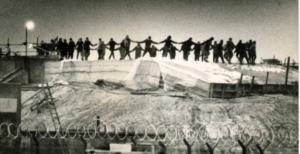On September 5, 1981, a small group of mainly Welsh women chained themselves to the main gate of the United States airbase at RAF Greenham Common in Berkshire They had walked 100 miles from Cardiff with their ‘Women for Life on Earth’ banners in the Suffragette colours of green, purple and whiteIn public meetings en route they spoke of more than 50,000 nuclear weapons in the US and Soviet arsenals and criticized NATO’s recent decision to place American nuclear-armed cruise missiles into Greenham and other European bases in response to the deployment of Soviet SS20 missiles.
The women called for televised discussions with government ministers to find sensible ways to prevent nuclear war, stop nuclear escalation and work towards East-West nuclear disarmamentAfter being charged with ‘breach of the peace’ for singing in the sentry box inside the Greenham base, I became involved in keeping the peace camp going. Evictions and arrests prompted us to organize a massive protest on December 12-13, 1982, to ‘embrace’ and ‘close’ the nuclear base.
Taunted by Greenham guards to ‘stay as long as you want’, some of the marchers took up the invitation. The small group that was still there after a difficult winter resolved to make the camp ‘women only’, citing practical reasons and safety. From then, the Greenham Common Women’s Peace Camp became a magnet for women who wanted not just to abolish nuclear weapons but to end patriarchal systems of oppression and violence

fence with photos of their families, along with warnings from Hiroshima, Nagasaki and nuclear testing in the Pacific. Thousands of women then stayed over that sleet-filled night, far more than expected. We followed up on New Year’s Day 1983 by occupying and dancing on the half-built nuclear silos inside the base.
Actions like these brought global publicity and provoked debate. We emulated the Suffragettes’ 1908 ‘Rush on Parliament’ and stood against Prime Minister Margaret Thatcher and Defence Secretary Michael Heseltine in the general election of June that year as representatives of ‘Women for Life on Earth’. As the deadline for the new weapons to be deployed approached, we encouraged women to ‘carry Greenham home’ and campaign wherever they lived.We even launched a legal case with the New York-based Centre for Constitutional Rights and two members of the US Congress. In November 1983, before the US Federal Court could deliver its judgment on Greenham Women Against Cruise Missiles v Reagan, the first cruise missiles were flown into Greenham.
Our numbers varied: small groups around the Greenham campfires would become 50,000 women furiously pulling down miles of the perimeter fence in December 1983, followed by three women successfully occupying the Greenham Control Tower just after the cruise missiles arrived.From 1984 onwards, as bailiffs tried to close the camps on a daily basis and thousands of women spent – comparatively short – periods of time in Holloway Prison, we called for Greenham women to become active everywhere and set up ‘Cruisewatch’, with local residents, to stop nuclear missiles on mobile launchers being able to ‘melt into the countryside’ as the military intended.
It was a proud moment when Setsuko Thurlow from Hiroshima, an atomic bomb survivor and Greenham Woman, accepted the Nobel Peace Prize in Oslo in 2017 on behalf of the International Campaign to Abolish Nuclear Weapons and everyone who had contributed to the 2017 Treaty on the Prohibition of Nuclear WeaponsToday I worry about climate destruction as much as nuclear weapons. Life on Earth is more threatened now than in the 1980s. For me, Greenham is alive at the monthly Aldermaston Women’s Peace Camp, which we founded in 1984, and among climate activists.

